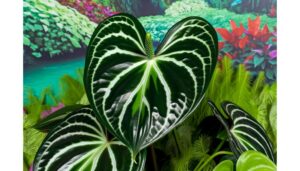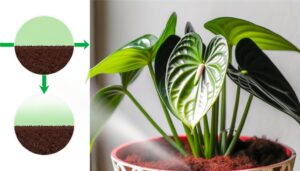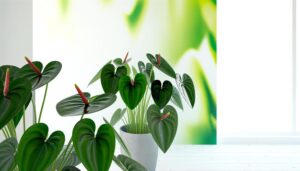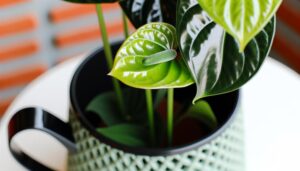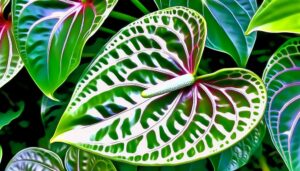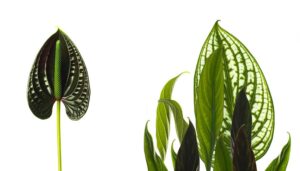Caring for Anthurium Wendlingeri X Scherzerianum – a Complete Guide
Anthurium Wendlingeri X Scherzerianum thrives under bright, indirect light, with an excellent photon flux density of 100-200 µmol/m²/s. Maintain balanced watering by irrigating when the top inch of soil is dry, ensuring consistency without waterlogging.
Utilize well-ventilated soil comprising 40% orchid bark, 30% sphagnum moss, and 30% perlite. Ideal temperatures range between 65-80°F (18-27°C) with 70-90% humidity.
Fertilize bi-weekly during growth with a diluted 20-20-20 NPK solution. Repot every 2-3 years and monitor for pests, using neem oil or insecticidal soap as needed.
Explore further for thorough care strategies and potential pitfalls to avoid.
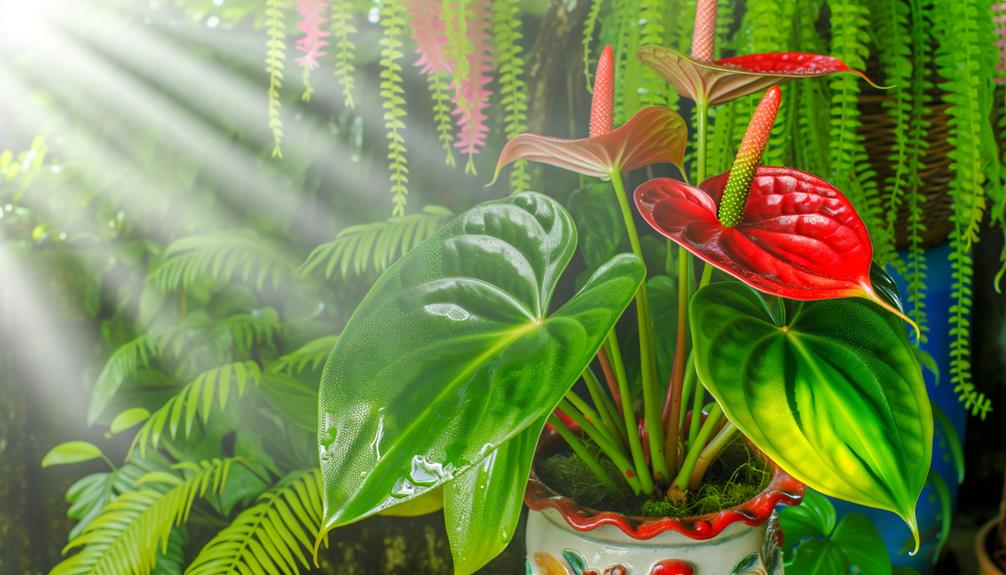
Key Takeaways
- Place in bright, indirect light and avoid direct sunlight to prevent leaf damage.
- Water when the top inch of soil is dry and maintain consistent moisture.
- Use a soil mix with 40% orchid bark, 30% sphagnum moss, and 30% perlite.
- Maintain temperature between 65-80°F and humidity levels between 70-90%.
- Fertilize bi-weekly with a diluted 20-20-20 N-P-K water-soluble fertilizer during active growth.
Ideal Lighting Conditions
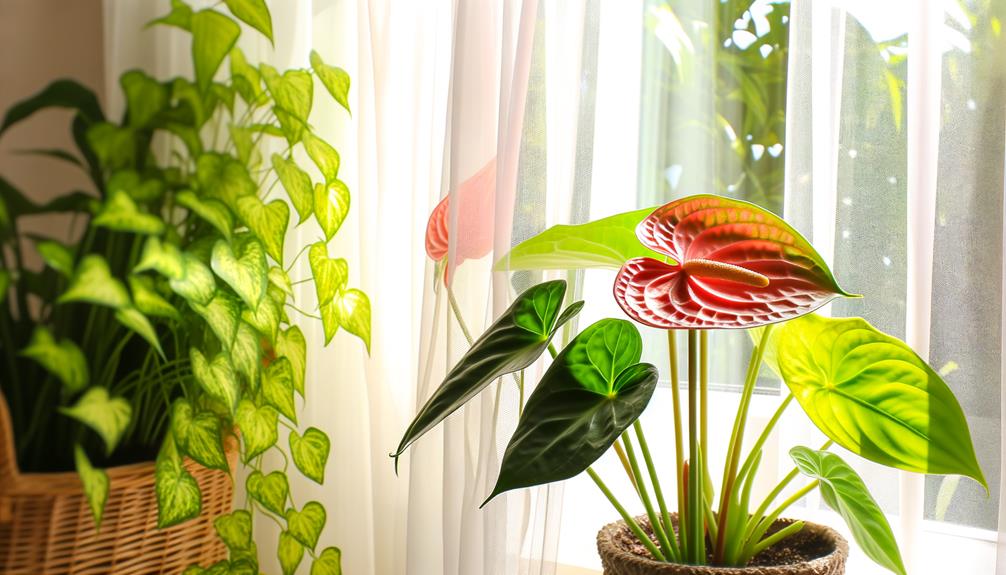
Ideal lighting conditions for Anthurium Wendlingeri X Scherzerianum involve bright, indirect light to mimic the dappled canopy of their native tropical environments. Direct sunlight can cause photoinhibition and leaf scorching, compromising the plant's physiological functions.
Excellent photon flux density ranges between 100-200 µmol/m²/s, ensuring adequate photosynthesis without overexposure. Artificial lighting, such as full-spectrum LED grow lights, should be considered in low-light settings to maintain consistent light quality and intensity.
Placement near east or north-facing windows is advisable, supplemented by sheer curtains to diffuse direct rays. Monitoring light levels with a quantum sensor can provide precise adjustments, ensuring the Anthurium receives its requisite light for optimal growth and foliage health.
Watering Schedule
Maintaining ideal moisture levels is essential for the health of Anthurium Wendlingeri X Scherzerianum, necessitating a well-balanced watering schedule.
This plant requires consistent moisture without waterlogging, with adjustments needed to account for seasonal variations in temperature and humidity.
Properly timed watering enhances nutrient uptake and supports vigorous growth cycles throughout the year.
Optimal Moisture Levels
Ensuring ideal moisture levels for Anthurium Wendlingeri X Scherzerianum involves maintaining a consistent watering schedule that aligns with the plant's specific hydration needs. This hybrid species thrives in environments where the soil remains uniformly moist but not waterlogged. Overwatering can lead to root rot, while underwatering can cause leaf desiccation.
Employing a well-draining potting mix, such as one containing orchid bark, perlite, and peat moss, facilitates optimal moisture retention and aeration. It is advisable to water when the top inch of the soil feels dry to the touch. Employing humidity trays or misting can supplement ambient moisture, simulating the plant's native tropical habitat.
Accurate moisture level maintenance is essential for fostering vigorous growth and overall plant health.
Seasonal Watering Needs
Understanding the seasonal watering needs of Anthurium Wendlingeri X Scherzerianum is essential, as fluctuations in temperature and humidity throughout the year directly influence the plant's hydration requirements. During the warmer months, typically from late spring to early autumn, the plant's metabolic rate accelerates, necessitating more frequent watering. Aim for maintaining consistently moist, but not waterlogged, soil.
Conversely, in the cooler months, from late autumn to early spring, reduce watering frequency as the plant's growth rate diminishes and its water uptake decreases. Guarantee the medium remains slightly damp to prevent desiccation.
Employing a precise watering strategy, adjusted for seasonal variations, will support the best health and vigor of Anthurium Wendlingeri X Scherzerianum.
Soil Preferences
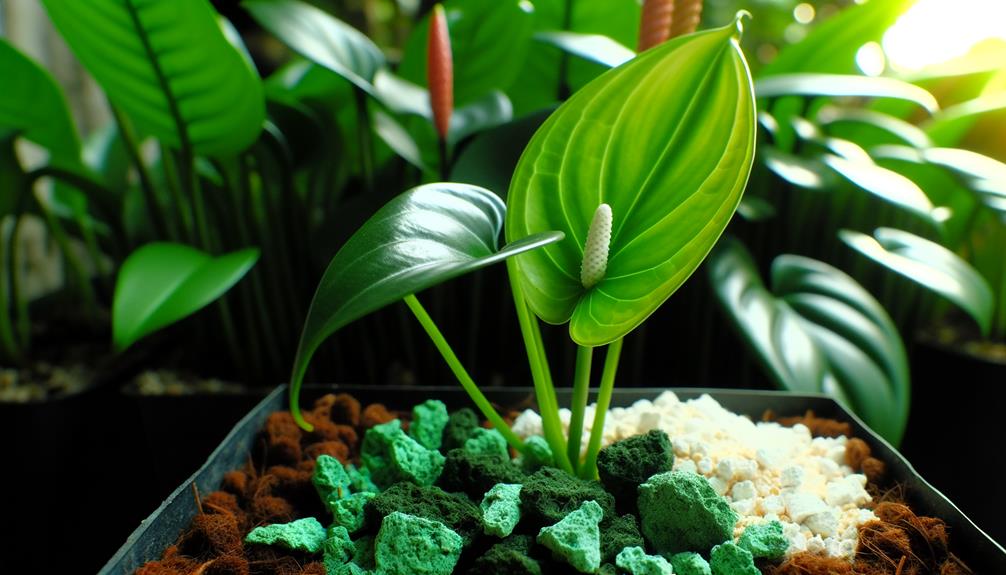
Anthurium Wendlingeri X Scherzerianum flourishes in a well-ventilated, loose, and nutrient-rich soil mix that closely imitates its natural epiphytic habitat. An ideal substrate should be composed of organic materials that retain moisture yet ensure efficient drainage and aeration. Components such as orchid bark, sphagnum moss, and perlite are recommended to create a balanced medium. This combination provides essential nutrients while preventing root rot and compaction, crucial for the plant's health.
| Component | Function | Proportion |
|---|---|---|
| Orchid Bark | Aeration & Structure | 40% |
| Sphagnum Moss | Moisture Retention | 30% |
| Perlite | Drainage | 30% |
This blend facilitates robust root development, supporting optimal growth and flowering.
Temperature and Humidity
Maintaining a consistent temperature range of 65-80°F (18-27°C) and high humidity levels of 70-90% is vital for the best growth of Anthurium Wendlingeri X Scherzerianum. These parameters mimic its native tropical environment, promoting ideal physiological processes.
Temperature fluctuations can induce stress, impairing growth and flowering. High humidity assists in maintaining turgor pressure, preventing desiccation of the delicate foliage. It also supports efficient stomatal function, essential for gas exchange and photosynthesis.
Utilizing a hygrometer to monitor humidity and a thermostat for temperature regulation ensures precise control. Employing humidifiers, pebble trays, or regular misting can help achieve desired humidity levels. Consistency in these environmental factors is necessary for the plant's overall health and vigor.
Fertilization Tips

To complement ideal temperature and humidity conditions, a well-structured fertilization regimen is crucial for the robust growth and vibrant flowering of Anthurium Wendlingeri X Scherzerianum. Utilize a balanced, water-soluble fertilizer with an N-P-K ratio of 20-20-20, applied bi-weekly during active growth periods. Dilute the solution to half the recommended strength to prevent nutrient burn.
Micronutrients such as magnesium, calcium, and iron are essential; select a fertilizer that includes these elements. During dormancy or reduced light periods, decrease fertilization frequency to once monthly. Regularly monitor the plant for signs of nutrient deficiencies or excesses, adjusting the regimen accordingly.
Proper fertilization, paired with suitable environmental conditions, ensures the best possible health and blooming performance.
Common Issues and Solutions
Anthurium Wendlingeri X Scherzerianum may experience yellowing leaves, often attributed to overwatering, nutrient deficiencies, or inadequate light conditions.
Pest infestations, particularly from spider mites, aphids, and mealybugs, can also compromise plant health.
Effective solutions involve adjusting watering practices, ensuring balanced fertilization, and implementing integrated pest management strategies.
Yellowing Leaves Causes
Several factors can contribute to the yellowing of Anthurium Wendlingeri X Scherzerianum leaves. Improper watering, nutrient deficiencies, and pest infestations are common culprits. Overwatering can lead to root rot, impairing nutrient uptake and causing chlorosis. Conversely, underwatering results in cellular dehydration, manifesting as yellow leaves.
Nutrient deficiencies, particularly of nitrogen, magnesium, or iron, disrupt chlorophyll synthesis, leading to interveinal chlorosis. Soil pH imbalances can further hinder nutrient availability, exacerbating yellowing. Proper fertilization and pH adjustment are essential to mitigate these issues.
Insufficient light can impede photosynthesis, resulting in pale, yellowing foliage. Ensuring ideal light conditions, balanced watering regimes, and adequate nutrient supply are paramount in maintaining the health and vibrancy of Anthurium Wendlingeri X Scherzerianum.
Pest Infestation Control
In addition to nutrient and water management, effective pest infestation control is critical for maintaining the health of Anthurium Wendlingeri X Scherzerianum. Common pests such as aphids, spider mites, and scale insects can cause significant damage to the plant's foliage and overall well-being.
Aphids are often found on new growth and excrete honeydew, leading to sooty mold. Spider mites, identifiable by their webbing, cause stippling and leaf discoloration. Scale insects adhere to stems and undersides of leaves, weakening the plant by extracting sap.
To combat these pests, utilize insecticidal soaps or neem oil for minor infestations. Systemic insecticides may be necessary for severe cases. Regularly inspect plants, ensuring proper air circulation and humidity levels to deter pests. Quarantine new additions to prevent contamination.
Conclusion
To recap, flourishing Anthurium wendlingeri x scherzerianum growth requires specific conditions: ideal lighting, proper watering, appropriate soil, and consistent temperature and humidity levels.
Fertilizing enhances development, while proactive measures in handling typical issues prevent potential plant issues. Following these instructions promises robust growth and well-being.
Applying knowledgeable tips and actions secures the lasting strength of this hybrid, blending gardening techniques with plant biology, thereby fostering long-lasting success and aesthetically pleasing display.

